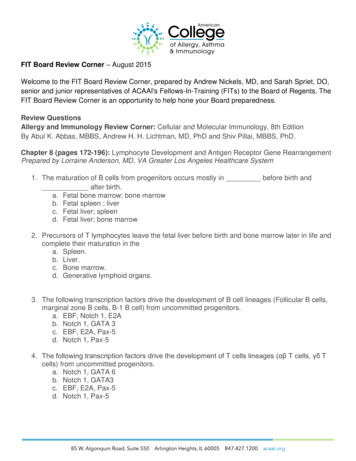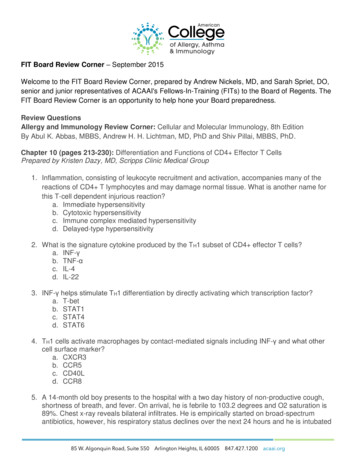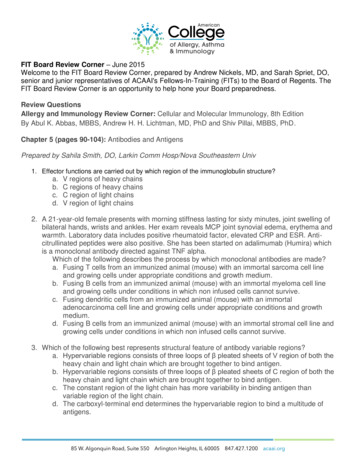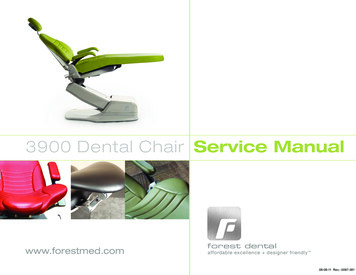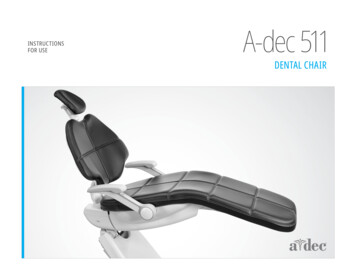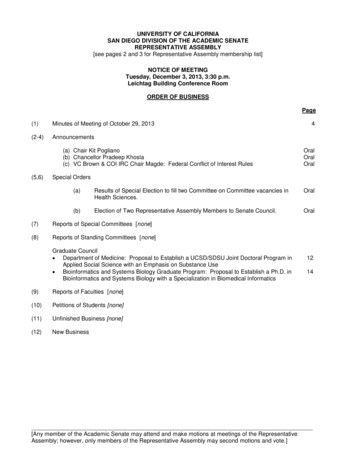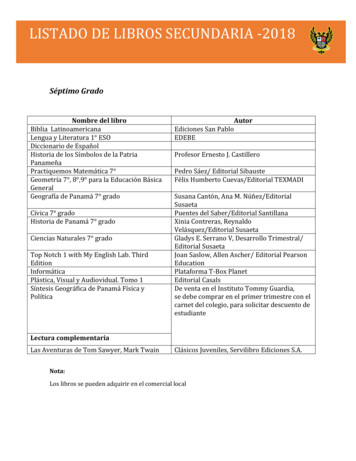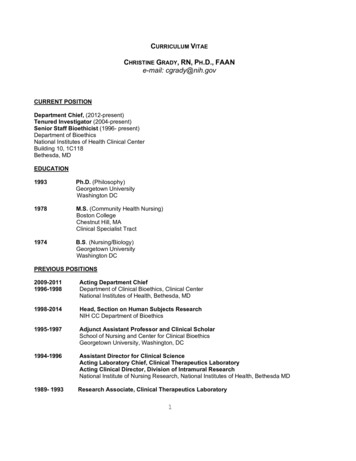
Transcription
ALUMNI PULSEDepartment of Physical Medicine and RehabilitationNew Jersey Medical SchoolD ec emb er 2 0 1 1Editorial BoardJoel A. DeLisa, M.D., M.S.Editor and Chair,Dept. of PM&RCommittee MembersChair’s CornerI want to wish each of you a safe,healthy and happy holiday seasonand a prosperous and peaceful New Year.As you know I have announced my retirement effective June 15, 2012. A searchcommittee is being established to help in the selection of the next chair.We have updated the Department website:http://njms.umdnj.edu/departments/physical medicine rehabilitation/index.cfmJohn Bach, M.D.Patrick Foye, M.D.I decided to update the Department History and it is the December Alumni Pulse.Any suggestion for improvement or correction is greatly appreciated.Susan Garstang, M.D.Doreen MuhammadDebra RoneyValerie Trupp, M.B.A., C.R.A.The Education Advisory Committee to the Governor has not completed its report(present deadline is December 15, 2011). It does appear that Robert WoodJohnson Medical School, the Public Health School and the New Jersey CancerInstitute will move to Rutgers. It is unclear how the Newark area colleges/Universities will be configured. It is an uncertain time, and we do need a FINALdecision so we can plan and move on. I strongly encourage you to make a charitable donation to support our residencyprogram. Make your checks payable to NJMS Department of PM&R.For information about theDept. of PM&R, you may visitour website at:www.umdnj.edu/pmrwebIt has been an amazing 25 years. We built a very strong department and trainingprogram. I want to thank you for your encouragement and support.Best Wishes,Department of PhysicalMedicine and Rehabilitation30 Bergen Street, ADMC 101P.O. Box 1709Newark, NJ 07101-1709Joel A. DeLisa, M.D., M.S.Professor and Chair
History of the Department of Physical Medicine and Rehabilitationand the Residency and Post-Doctoral Training Programs Through 2011Joel A. DeLisa, M.D., M.S.Luba Stefaniwsky, M.D.Richard Sullivan, M.D.In October 1952, the Veterans Administration Hospital in East Orange, New Jersey was opened with all essential clinical servicesand a well-staffed, well-organized, well-equipped and spacious Physical Medicine and Rehabilitation (PM&R) Service. Dr. CharlesBrooke, the Chief of Service, who was experienced in Military Medicine, recognized the importance and need for services in PM&Rin the state of New Jersey and within the VA health care system. His idea and vision for the future of PM&R gradually took shape.With the help of prominent physicians like Dr. Arthur Abramson, Professor and Chairman at Albert Einstein College of Medicine ofYeshiva University, Bronx, New York; Dr. Henry Kessler, Medical Director of the Kessler Institute, West Orange, New Jersey; andDr. Q.B.C. Knudson, Director, PM&R Services at the Veterans Administration, Washington, D.C., this idea became a reality. Thesephysicians played an important and vital role in the proposal, formation, and organization of the residency training program. TheAmerican College of Graduate Medical Education first officially recognized the residency training program on September 19, 1955.In 1958, the first three-year PM&R residency program in the State of New Jersey was approved by the American Board of PhysicalMedicine and Rehabilitation. Initially, six positions were offered, but shortly, due to budget constraints, the number was reduced tofour. There were two types of training programs: a regular three-year program, and a VA career program that offered a higher salary,but required an additional two years of service in the VA system after completion of training. Subsequently, the residency programwas accredited for three years and eventually five years during each external review. This program was affiliated with the AlbertEinstein College of Medicine in the Bronx, New York and the Kessler Institute in West Orange, New Jersey, for training in pediatricrehabilitation and exposure to the rehabilitation of females. Dr. Charles Brooke, who was one of the charter diplomates at theformation of the American Board of Physical Medicine in 1947, served as the first residency training director as well as the Chief ofService.Dr. Manolio was Assistant Chief and Dr. Lemenson was in charge of the 40-bed VA rehabilitation service, including 20 bedsdesignated for the care and rehabilitation of traumatic spinal cord injury. A PM&R evaluation clinic was conducted daily andprovided consultation for patients referred from other clinical areas in the hospital. Supervision and teaching of residents wasprovided by Drs. Brooke, Manolio, Hoerner, and Panin. Education was enhanced by the contribution of prominent consultants suchas Drs. Abramson and Kessler.When Dr. Brooke retired in 1969, Dr. Luba Stefaniwsky, who in 1958 had been the first resident accepted into this training programin New Jersey (at an annual salary of 2,840), became the next Chief of Service and Residency Program Director. The Servicecontinued to grow and delivered high quality patient care. In addition to physical, occupational, and corrective therapies, specialprograms were provided such as driver training for the disabled, pre-vocational exploration and training, an educational programleading to the granting of high school equivalency diploma (GED), and recreational therapy. During Dr. Stefaniwsky’s directorship,the Spinal Cord Injury program became an independent service. The PM&R Service was renamed the Rehabilitation MedicineService and was relocated with a reduction of bed capacity to 20 beds.The existing electromyography (EMG) training was enhanced by the construction of a fully insulated electrodiagnostic laboratoryequipped with state-of-the-art EMG equipment. It provided a diagnostic facility for patients referred from all services in the hospitaland the outpatient clinics. Dr. Weigand was in charge of this unit and Dr. Miglietta, a well-known consultant in EMG, contributedsignificantly to the education and training of residents in electrodiagnosis.The Cardiac Rehabilitation Unit was organized in 1973 under the leadership of Dr. Angeles Flores, Assistant Chief of Service, askilled and highly qualified Cardiac Rehabilitation Physiatrist. This was the first cardiac rehabilitation program in the state under theleadership of a physiatrist. It was a very useful and successful program and had significant impact on prognostic developments incardiology and pulmonary diseases. For residents it was a unique opportunity to acquire skills and experience in cardiacrehabilitation. This program is still functioning today. The Amputee Clinic was transferred from the Orthopedic Service to theRehabilitation Service and was conducted by a Physiatrist, Dr. Paul Loong, for both hospital and ambulatory care patients.To facilitate training and to assess the ability of disabled patients to live independently, a special training area was designated, calledthe “Apartment.” This facility simulated living quarters and contained a kitchen, a bathroom, a bedroom, and a family room. It servedas a model facility for other rehabilitation centers in community and VA hospitals, especially for SCI centers.2
This VA Residency Program in PM&R was established by pioneers in the field of rehabilitation who had creative ideas and vision, itwas fully funded by the Veterans Administration in Washington, DC. The goal, commitment, and mission of the residency programwas to educate and train physicians to serve the chronically ill, disabled, and handicapped population in the State of New Jersey andin VA Hospitals. That mission was very well accomplished, because many physicians who completed the residency programs duringits first two decades entered the practice of physiatry in the state or in VA hospitals and nursing homes.The VA provided physiatry training that was clinically-oriented. A few papers were published, as research was minimal. Theprogram served as a foundation for the development of today’s medical school-based and more academically-oriented residencyprogram.A Residents’ Day was established in 1970 that featured an annual presentation of selected topics to the members of the New JerseySociety of Physical Medicine and Rehabilitation. This was a very successful and rewarding event and was a forum for residents tointeract with other physiatrists in the state. This program has been continued each year through the present.The State of New Jersey took over the Seton Hall Charter in 1965 and it became the New Jersey College of Medicine. The MedicalScience Building opened in 1977. While Seton Hall had the charter, it never enrolled any students. Dr. Richard Sullivan wasappointed as the Acting Chairman of the Department of Rehabilitation Medicine on September 15, 1975 and served until 1987. Healso was the Medical Director of the Kessler Institute for Rehabilitation (KIR) from 1969 to 1987. His appointment at the College ofMedicine and Dentistry of New Jersey was based on a 20% time commitment. He administered the department from his office atKIR, but had an office in the University Hospital and Martland Building that was moved around from time-to-time. Beginning in1976, he identified 17 physiatrists from surrounding hospitals to receive faculty appointments to assist in the residency trainingprogram. The residency program under Dr. Sullivan’s leadership had grown to seven funded positions over the three years oftraining. The opening of the Medical School in Newark, New Jersey broadened the scope and focus of the residency program.Residents now had the opportunity to participate in the teaching of medical students and to interact with the medical school faculty.In July 1982, the College of Medicine and Dentistry of New Jersey took over the responsibility for this residency program. Dr.Sullivan remained as the Acting Chairman, but also assumed the role of Residency Program Director, and the number of trainees wasexpanded to nine residents. Rotations included the KIR, College Hospital (now University Hospital), the VA Hospital in EastOrange, and Children’s Specialized Hospital in Mountainside. Grand Rounds were initiated on the first Friday of each month, withthe location rotating among the teaching sites. In addition to Dr. Sullivan, the faculty by 1982 consisted of eight clinical instructors,four clinical assistant professors and three clinical associate professors. This included two full-time and two half-time faculty paid byUniversity Hospital. During this period, the voluntary faculty were encouraged to attend grand rounds and to play a stronger role inthe teaching program.The initial teaching hospital was the Martland Hospital currently the Bergen Building. It housed a physical and occupational therapyunit, an administrative suite and one full-time physiatrist. A new University Hospital opened in 1979, but it did not have arehabilitation inpatient bed service and had only limited space for therapy. The inpatient bed service for residency training waslocated at KIR, while the outpatient clinics were developed in the Martland building. It was during this time that Children’sSpecialized Hospital became an affiliate of the program to provide pediatric experience. While the residency-training program had animmense amount of clinical inpatient and outpatient material, it lacked administrative oversight, needed more resident slots, and aprogram director with more dedicated time, and it was on provisional accreditation.Dr. Joel A. DeLisa was recruited as the first department Chairman of PM&R in 1987 with 50% of his time allocated to UMDNJ-NewJersey Medical School and the University Hospital, and 50% of his time allocated to the Kessler Institute for Rehabilitation (KIR) asits Medical Director. Administrative space and support staff for the department as well as two additional physician FTEs wereprovided at University Hospital for a total of three. The therapy areas were enlarged. The University Hospital also provided twoadditional resident salary lines for a total of four and KIR provided an additional 10 for a total of 14. Over the ensuing 12 years thetotal number of resident positions grew to a maximum of 30, and by July 2009, to 26. Presently it is 27. The allocation of residentpositions among the affiliated institutions as of July 2011 is listed in TABLE 1. From 1974 through 2011, there were 186 graduatesof this program.The overall goals of the department’s training program are to enable the graduating residents to practice Physical Medicine andRehabilitation independently at an entry level, and to assure they pass both parts of the certifying examination of the American Boardof Physical Medicine and Rehabilitation. After completing our training program, each resident is expected to have mastered the skillsnoted in TABLE 2.3
The department recognized the urgent need in the field to attract additional individuals to rehabilitation research as well as toenhance the research credentials of those already interested or active in the field. Thomas Findley, MD, PhD, was the first ResearchDirector at the Kessler Institute for Rehabilitation. This slot was part of Dr. DeLisa’s recruitment package. He laid the foundationfor the present larger research program. To this end, the department established a core curriculum in research for residents, which istaught each fall in a six-week comprehensive course. Residents are expected to learn how to critically evaluate medical literature,formulate research questions, design a method to test those questions, follow through with data collection, analyze results, andprepare and submit for publication a manuscript satisfactory to their faculty research advisors. The department offers residents theopportunity to devote one half-day per week for up to six months of full-time effort to a research experience that is closely integratedwith the residency program. ‘Seed Dollars’ are also available for specific research projects. To obtain dedicated research time theresident must receive approval of the Department’s Graduate Medical Education Committee and must be performing well clinically.Beginning in 1989, every PGY-2 resident has been required to write a review paper on a topic of his/her choice as part of the basicrequirements to complete the residency program. From 1989 through 2011, 105 peer reviewed articles have been published by ourtrainees, with 17 in the past three years. Additional opportunities for further advanced research training are now available through theUMDNJ-Graduate School of Biomedical Sciences, including the option to obtain a masters or Doctorate degree in the field ofNeurosciences (TABLE 3). In 2011 the department sponsored its 22nd annual resident/fellow/post-doctoral fellow research day,which featured 16 trainee research presentations. An annual award is given for the best resident research presenter and the best postdoctoral presentor.The training program has produced pioneering work in objectively evaluating the clinical competency of its trainees, particularly inthe use of the objective structured clinical examination (OSCE) under the leadership of Dr. Sudesh (Sheela) Jain. Peer reviewedarticles have been published by our faculty, dealing with evaluating the competency of the physiatric trainee1,2,3,4 and with physiatrygraduate medical education.5-44One strength of the current program has been the modular topic didactic lecture series that is repeated on an 18-month cycle. Thedidactic series is mandatory and is scheduled each Wednesday from 8:00 a.m. until noon and also on the first Friday of each month,also from 8:00 a.m. until noon (TABLE 4). Approximately two-thirds of these lectures are given by faculty. This series issupplemented by in-house resident courses such as electromyography, prosthetics, orthotics, administration/business,professionalism, job searching skills, and speech and swallowing. The department also sponsors the nation’s largest Annual BoardReview Course scheduled over a nine-day period, which is attended by residents from across the country. 2011 is the 23rd year thiscourse has been offered. We held two “state-of-the-art” conferences that we published as supplements to major journals, “Quality ofLife Measurement: Building an Agenda for the Future” – November 16 & 17, 2001, and “Clinical Trials in Medical Rehabilitation:Enhancing Rigor and Relevance” – November 1 & 2, 2002. We had planned to host one on “Rehabilitation Engineering andRobotics,” but that was never accomplished.In addition to the residency training, the Department also recognized the need to train the next generation of rehabilitationresearchers in the allied health professions. As such, starting in about 1990, several grants from the National Institutes of Health (e.g.T32) and NIDRR (e.g., Advanced Rehabilitation Reaserach and Training grants) were awarded, and the training of research fellowsbecame a major focus of new and exciting rehabilitation research. The program has grown significantly over the years, and there arecurrently 12 post-doctoral fellows in diverse areas such as psychology, cognitive neuroscience, speech –language pathology, bioengineering, and neurology. Dr. John DeLuca has served as the Director of the Post-doctoral Fellowship Program since its inception.Teaching residents is vital to the success of the residency and post-doctoral fellowship programs, and excellence in teaching isrecognized by the annual PM&R faculty teaching award. This was started in 1988 and is given to the faculty member who has beenvoted by the residents as the outstanding teacher of the year (TABLE 5). The program has also offered an extensive array offellowships (TABLEs 6-10), the resident’s double boarding program (TABLE 11), as well as Postdocs (TABLE 12). About 30-40%of every graduating class pursues additional training. The trainees have won many national awards and recognitions (TABLE 3). Ourgraduating residents have been awarded the Elkins Award (highest score on the written certification examination seven times(TABLE 3). Several of our post-doctoral fellows have received early career awards in recognition of their outstanding contribution torehabilitation research (TABLE 3) The department has published a bi-annual alumni newsletter entitled “Alumni Pulse” since 1995.Our graduates are formally surveyed approximately every three years to identify areas that should receive greater emphasis in thetraining program.The research and education programs of the department were strengthened in January 1998 with the creation of the Kessler MedicalRehabilitation Research and Education Corporation (KMRREC). KMRREC was an international rehabilitation research andeducation organization whose primary purpose is to generate data and procedures that can be used to improve performance in4
patients served by rehabilitation facilities in the United States and throughout the world. Dr. DeLisa was the President and CEO ofKMRREC until June 30, 2008. He was their Founding Director until June 30, 2010. Its professional staff holds faculty appointmentswithin the PM&R Department. It has approximately 23,000 square feet of research space. It has dedicated research laboratories suchas medical rehabilitation outcomes, neuropsychology and neuroscience, rehabilitation engineering analysis, and human performanceand movement analysis. These laboratories are supported by core resources including administration and computer services. Projectsin areas such as spinal cord injury, traumatic brain injury, stroke, multiple sclerosis, and musculoskeletal diseases extend across thelaboratories. KMRREC’s name was changed in 2008 to the Kessler Foundation Research Center (KFRC). 2011 saw significantgrowth at KFRC. KFRC doubled its research capacity by adding approximately 20,000 sq ft to its sister campus at 300 ExecutiveDrive in West Orange. Two key senior scientists were recruited; Jordan Grafman, Ph.D. came from the NIH, where he was theDirector of the Cognitive Neuroscience laboratory, to serve as the Director of the TBI Laboratory at the KFRC. Guang Yue, Ph.D.was recruited from the Cleveland Clinic, where he served as the Director of the Laboratory of Neural Control of Movement in theDepartment of Biomedical Engineering, and will be the Director of the Human Performance and Engineering Laboratory at KFRCstarting January 2012. In addition, several key strategic investments were made that will significantly increase the research mission ofKFRC. First, the KF Board approved the purchase and development of an MRI Center dedicated to rehabilitation research to belocated on the 1199 Pleasant Valley Way campus and will be operational in 2012. Second, KF also purchased the state of the artLocomat, and robotic device designed to improve mobility in various clinical populations including SCI, stroke, TBI and MS. Third,KFRC purchased the Ekso exoskeleton, which is a wearable, robotic, battery-powered exoskeleton that enables wheelchair users tostand and walk. Lastly, KFRC has provided a grant to the Christopher and Dana Reeves Foundation to support research using in-vivoepidural electrical stimulation to increase mobility in severely disabled patients.The current resident training program is based at UMDNJ-New Jersey Medical School and University Hospital in Newark, with thefollowing affiliated training institutions: Kessler Institute for Rehabilitation, the New Jersey Veterans Affairs Health Care System,Children’s Specialized Hospital, and Mountainside Hospital (TABLE 1). The department has a vast amount of clinical material, andthe residents see all the patient populations mandated by the ACGME PM&R residency review committee. Administrative oversightis provided to the training program by the department’s Graduate Medical Education Committee. It consists of faculty representativesfrom each affiliated institution, the Vice President for Research and the Director of Education at Kessler Foundation, the residencytraining director, two chief resident representatives (administrative and academic), the residency program’s administrativecoordinator, and one clinical fellow representative. This committee meets on the second Tuesday every other month and monitors thetraining program and the trainees’ experience. Other department committees are listed in TABLE 13. A resident policy andprocedure manual has been developed, as well as patient/procedure logbooks and a Department Logo (TABLE 14). The trainingprogram received a full five-year accreditation by the PM&R Residency Review Committee (RRC) of the Accreditation Council forGraduate Medical Education (ACGME) at the most recent site visit in May 2009. We received a five year accreditation for both theGeneral and the SCI Medicine Program. This is the maximum that can be obtained. The General Program demonstrated substantialcompliance with the ACGME requirements without citations. The committee particularly commended the program for its extensiveand excellent educational curriculum, use of OSCE for competency assessment, the emphasis on scholarly activity among the faculty(especially among the residency staff), and the outcomes regarding ABPMR Board scores.The department conducts a mandatory medical student teaching program and approximately 175 New Jersey Medical Schoolstudents annually take the two-week mandatory PM&R rotation in their third or fourth year. This clerkship was part of Dr. DeLisa’sinitial recruitment package. We teach in all four years of the medical student curriculum. This student exposure has resulted in manymedical students choosing physiatry as their career. We are in the top ten of medical schools recruiting students into our specialty(TABLE 15a & 15b). Our faculty has also taught in the problem-based learning course for five years, and in the musculoskeletallectures as part of the Introduction to Clinical Science course for second-year medical students. In 1999, we initiated a series ofmusculoskeletal workshops using standardized patients for the medical students. Additionally, since 1992, the department hassponsored a summer research fellowship for interested medical students. Over the past five years, a total of nine medical studentshave participated. One of our faculty gives the gait lecture in the Gross Anatomy course and our residents teach first-year medicalstudents in the gross anatomy laboratory. Each year we also average about 75, two-or four-week medical student electives, half ofwhich are filled with students from other schools. However, in 2010/11 we had 102. We have used a printed medical student syllabusfor 12 years that is updated annually. The residents are very active in medical student teaching and they are given formal instructionsin how to improve their teaching skills. An award is given to the resident who is the best teacher, from the medical students’perspective (TABLE 16). Since 1996, the department has offered an Annual Medical Student PM&R Award, given to theoutstanding fourth year NJMS medical student. Faculty members serve as medical student advisors and conduct interviews ofprospective students for the Medical School Admissions Committee. In 2007 a PM&R Medical Student Special Interests Group wasstarted. It has been very successful. Dr. DeLisa’s philosophy is that we will accept all medical student curriculum teachingopportunities. We believe this department offers the largest amount of medical student exposure to the specialty in the nation.5
Dr. DeLisa has served as the Residency Program Director or Co-Director from1987-2005. Susan Garstang, M.D., joined the facultyin July 2005 as Residency Program Director. Others who have served as training director are listed in TABLE 17. The programstresses clinical competency from its trainees. The overall philosophy of the department is to encourage its graduates to be advocatesfor the disabled and to professionally contribute more than they receive. The department strives to be a leader in the training of theacademic physiatrist and to be actively involved in graduate medical education at the local and national levels. The departmentannually invites an outstanding academic physiatrist to receive the New Jersey Medical School National Teaching Award inPhysiatry (TABLE 18). These individuals spend two days with the faculty and residents adding to the academic milieu.By the mid-1990s, the department had developed a website, primarily as a tool for recruitment of resident candidates. By the turn ofthe century this medium had broadened its scope to begin addressing the needs of the department’s other constituencies, such as itsmedical students, its faculty, its alumni and its postdoctoral fellows. While some enhancements have been made, the department hasonly partially realized its vision for using web-based media, due to limitations in funding as well as a dependence on outside entitiesfor programming expertise. This website links to the Kessler Foundation website (http://www.hhkfdn.org/) that describes its researchand education initiatives.In 2001 the department initiated a strategic planning process to update an earlier plan that had been developed in the mid-1990s. Thenew effort was spearheaded by the chairs of the eight major committees that address the major functional areas of the department(TABLE 13): (See the PM&R website at: http://njms.umdnj.edu/departments/physical medicine rehabilitation/index.cfm). Alumni Medical Clinical Fellowships Appointments & Promotions CommitteeContinuing Medical EducationGraduate Medical Education Post doctoral traineesResearch In addition to its weekly didactics lecture series and monthly grand rounds series, the department also sponsors lectures by prominentspecialists on topics that will be of interest to its trainees and faculty. The Excellence in Clinical Practice series, sponsored by Procter &Gamble, and now known as the Scott Nadler, D.O. Memorial Lecture brought an outstanding musculoskeletal practitioner to the departmenteach year. Another series known as the Elizabeth Narcessian Memorial Lecture honors a deceased PM&R faculty member who was knownfor her compassion toward patients experiencing pain. Recent presenters in these named lecture series have been as octer & Gamble Excellencein Clinical Practice LectureMichael Geraci, Jr., M.D., PTJoel M. Press, M.D.Edward Laskowski, M.D.William F. Micheo, M.D.Jay Smith, M.D.Larry H. Chou, M.D.Heidi Prather, M.D.Michael Fredrickson, M.D.Elizabeth Narcessian Memorial Lecture2001: Russell K. Portenoy, M.D.2002: James Rainville, M.D.2003: Gregory J. Rokosz, D.O., JD2004: Andrea Cheville, M.D.2005: Joseph Valenza, M.D.2006: Jeffrey A. Berman, M.D.2007: Michael Brennan, M.D.By 2011, the department had grown to 105 faculty members (including clinical titles) and these faculty members publishedapproximately 50 peer-reviewed articles, nine book chapters and two books per year. Educational articles by faculty are noted inTABLE 19. A complete list of faculty appointments within the department in June 2009 is provided in TABLE 20, while acumulative list of textbooks authored by the faculty during the period from 1994 to 2011 is provided in TABLE 21. The departmenthas presented an annual Distinguished Alumni Award since 1999. The annual recipients are noted in TABLE 22. External grantfunding has increased to approximately 4 million in 2011 at the Kessler Foundation Research Center and 730,000 per year atUMDNJ’s Newark campus, including training grants. As of 2008, the department conducts grants from the National Institute onDisability and Rehabilitation Research (NIDRR) for both a Spinal Cord Injury Model System and a Traumatic Brain Injury ModelSystem. These are administered through the Kessler Foundation Research Center.The department ended 2011 with five paid faculty located at UMDNJ-NJMS in Newark. Those faculty who have been employed byeither New Jersey Medical School or University Hospital are noted in TABLE 23. Medical R
Department of Physical Medicine and Rehabilitation 30 Bergen Street, ADMC 101 P.O. Box 1709 Newark, NJ 07101-1709 ALUMNI PULSE Department of Physical Medicine and Rehabilitation

